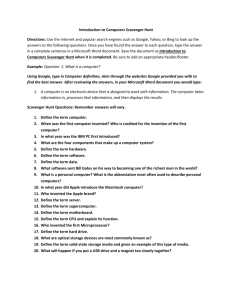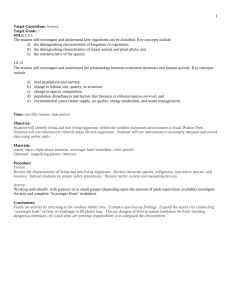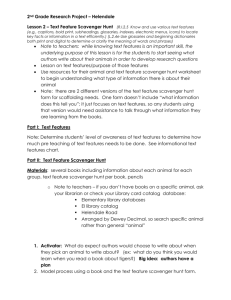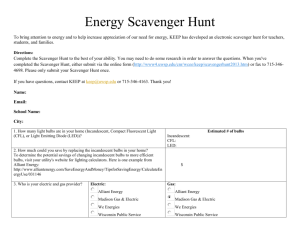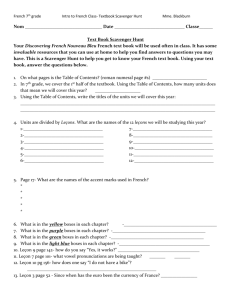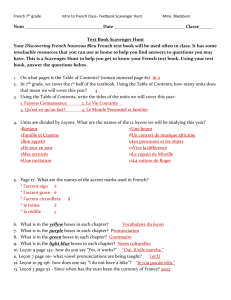Project K12-Search: An Internet package including Internet lessons
advertisement
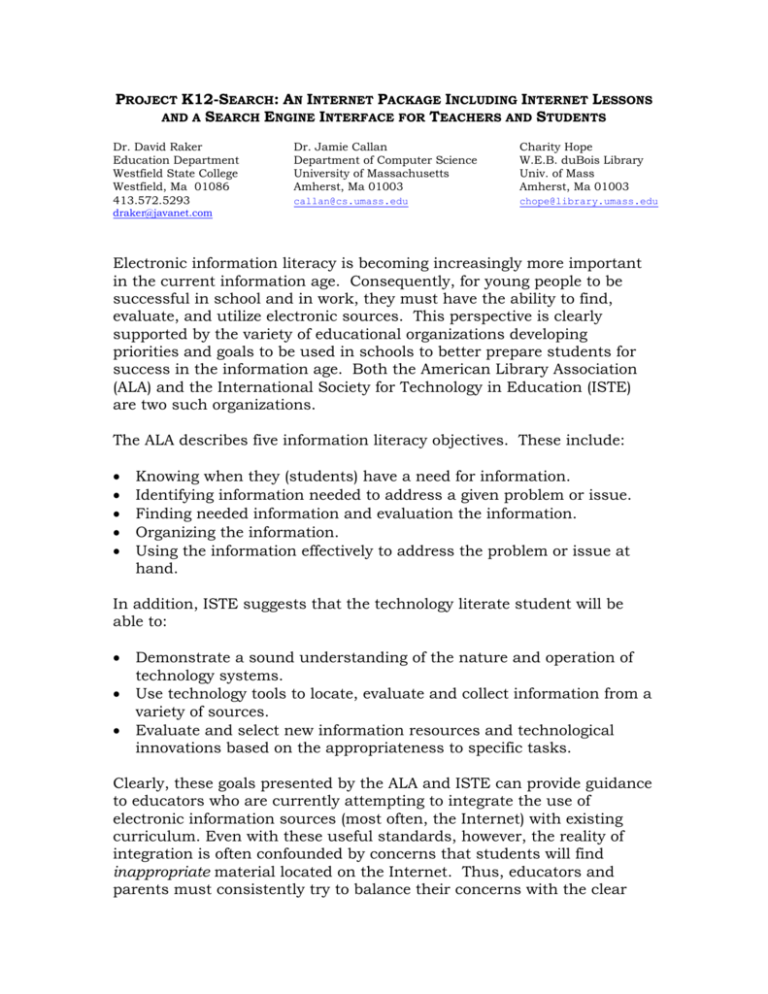
PROJECT K12-SEARCH: AN INTERNET PACKAGE INCLUDING INTERNET LESSONS AND A SEARCH ENGINE INTERFACE FOR TEACHERS AND STUDENTS Dr. David Raker Education Department Westfield State College Westfield, Ma 01086 413.572.5293 Dr. Jamie Callan Department of Computer Science University of Massachusetts Amherst, Ma 01003 Charity Hope W.E.B. duBois Library Univ. of Mass Amherst, Ma 01003 callan@cs.umass.edu chope@library.umass.edu draker@javanet.com Electronic information literacy is becoming increasingly more important in the current information age. Consequently, for young people to be successful in school and in work, they must have the ability to find, evaluate, and utilize electronic sources. This perspective is clearly supported by the variety of educational organizations developing priorities and goals to be used in schools to better prepare students for success in the information age. Both the American Library Association (ALA) and the International Society for Technology in Education (ISTE) are two such organizations. The ALA describes five information literacy objectives. These include: Knowing when they (students) have a need for information. Identifying information needed to address a given problem or issue. Finding needed information and evaluation the information. Organizing the information. Using the information effectively to address the problem or issue at hand. In addition, ISTE suggests that the technology literate student will be able to: Demonstrate a sound understanding of the nature and operation of technology systems. Use technology tools to locate, evaluate and collect information from a variety of sources. Evaluate and select new information resources and technological innovations based on the appropriateness to specific tasks. Clearly, these goals presented by the ALA and ISTE can provide guidance to educators who are currently attempting to integrate the use of electronic information sources (most often, the Internet) with existing curriculum. Even with these useful standards, however, the reality of integration is often confounded by concerns that students will find inappropriate material located on the Internet. Thus, educators and parents must consistently try to balance their concerns with the clear utility of providing such a powerful tool for learning. Project K12-Search, therefore, is a collaborative effort which attempts to address many of these concerns and ultimately help schools better utilize the Internet and reach the goals detailed by ALA and ISTE. Specifically, Project K12Search consists of both a set of student lessons that focus on the development of information literacy skills and a new type of Internet search engine interface that better reflects the needs and concerns of the K-12 environment. Three main goals help guide our work: To develop strategies that will help students better understand what the Internet is and how it works. To explore guided learning opportunities that will help students better find, evaluate, and utilize Internet resources (electronic information literacy skills). To develop an Internet search engine that will better help students find and explore age and content appropriate materials throughout the Internet. An additional point here is that the skills being developed though the efforts of this project are not exclusively computer specific. In other words, the students will be able to apply the information literacy skills learned to non-electronic sources as well. Lesson Plans Project K12-Search consists of 14 lessons that can be used either as a unit or separately to help students in their learning of specific Internet related material. These lessons have been field-tested with elementary students, but could also be modified for students at the middle and secondary levels. The lessons were developed to introduce a number of Internet and information literacy related topics. Some of these topics apply more specifically to younger students, but other students (of all ages) too can benefit. Although diverse in scope, each of the lessons has certain commonalties as well. For example, each lesson utilizes a dynamic, hands-on approach to learning. Also, both student and teacher evaluation is stressed throughout. Lastly, many of the lessons require little or no actual Internet access. This allows schools not yet “wired” to still introduce important topics to students who might have Internet access at home or through the library. Lesson One: A Guided Tour More and more schools are providing their students access to the Internet. While some students have the skills needed to manipulate this media, others are either not aware of or need assistance in finding what is available on the Internet. Schools must, therefore, help provide all students with the basic skills needed to find and utilize information on the Internet. This pre-assessment lesson is developed to help teachers better determine the Internet skill level of each student as well as to provide time for each student to learn basic computer skills need to use the Internet. Lesson Two: The Internet Simulation The Internet simulation lesson is a first step in conveying to students the idea that the Internet is not a ‘place’, rather it is made up of a large number of computers located around the world and connected by telephone wire. In addition, the simulation lesson demonstrates to students that specific questions must be addressed to appropriate locations. The simulation accomplishes this by providing students the opportunity to visualize in their own minds what the Internet is and, in a very general sense, how it works. Lesson Three: The Scavenger Hunt I The Internet Scavenger Hunt is a sequence of four lessons that teach students to find information in Internet documents. The emphasis is on locating answers to specific questions, and on locating information that indicates how reliable the answers might be. The Scavenger Hunt questions fall into three categories, with "content" questions considered easiest, "recency" questions considered more difficult, and "authority" questions being most difficult. This lesson is the first in the sequence of four lessons. The emphasis in this first lesson is on learning skills. Significant teacher interaction is involved, primarily in the form of providing guidance and answering questions as students perform the tasks. Lessons two, three, and four involve practicing and using the skills learned in this lesson, so less teacher involvement is required. Lesson Four: The Scavenger Hunt II This lesson is the second in the sequence of four lessons. The emphasis in this second lesson is on practicing skills. The tasks are accomplished in exactly the same manner as in the first Scavenger Hunt lesson. The only differences are that different sets of questions are used, and that the questions rely more on fill-in-the-blank rather than multiple choice. Teacher interaction is primarily in the form of answering questions as students perform the tasks. Lesson Five: Create-A- Hunt This lesson is the third in the sequence of four lessons. The emphasis in this third lesson is to provide an opportunity for students to explore more fully the Internet sites from Hunt I & II and create their own Internet Scavenger Hunt. Students, therefore, are expected to create questions (content, recency, & authority) that can be answered by their peers utilizing either the same web-sites used in Scavenger Hunt I & II, or with similar sites set by the teacher. Students can use the provided Question/Answer sheet to help direct their Create-A-Hunt. Teachers might need to help as students first locate information to create questions and then attempt to answer questions established by classmates. Lesson Six: The Scavenger Hunt Poster This lesson is the forth in the sequence of four lessons. The emphasis in this third lesson is on using Scavenger Hunt skills to accomplish educational tasks. The task is to create a poster that provides information about some subject and the Internet site that was the source of information. Teacher interaction is primarily in the form of answering questions as students perform the tasks. Lesson Seven: Computer Matching Simulation Successful information seeking depends on a student's ability to clearly understand and articulate the information that is needed (the question). Searching the web, students also need to learn how to ask for the needed information in a way that will yield the best results – they need to understand what the computer "understands." The Computer Matching lesson is designed to teach a student the "pre-search" skills of understanding the central information need by understanding the question and considering the different ways a question can be asked. The lesson also introduces students to a simplified idea of how search engines work; computers are good at recognizing words, not ideas. The strategy of query expansion-trying more than one word-is revealed. Although these skills are transferable to information seeking in print environments or with a variety of search engine interfaces, a primary goal of the lesson is to prepare students for the K12-Search Interface, which will allow them to add extra keywords to their search questions. Lessons 8-14: Lessons 8-14 are still under development. Each of these lessons, however, will focus more closely on the use of the K-12 Search Engine. What follows is a list of proposed lessons, some of which are near completion. Stating Your Information Need Introduction to K12-Search Evaluating Search Results Search and Evaluation Practice I Search and Evaluation Practice II Search and Evaluation Practice III Search and Evaluation Poster K12-Search Engine Too often the utility of Internet content must be weighed against the effort a child or teacher must expend to find material suitable for a particular lesson. Simply put, searching for information on the Internet can be time consuming and frustrating. One variable confounding a better match between the needs of educational institutions and the power of the Internet is the dependence on traditional Web search engines to find appropriate educational material. These Web search engines provide raw horsepower, but offer little assistance in guiding and harnessing this power. In other words, Web searches often suffer from high recall (many useful things found) and low precision (even more useless things found). Teachers, and especially children, do not have the time or the attention span to sift through large numbers of documents to find the few of interest. K12-Search is developing software that helps bring the power of the Internet and Web search engines to the classroom in a form suitable for teachers and students. K12-Search is a new graphical user interface developed exclusively for K-12 schools and their specific needs. For example, one unique characteristic of the K12-Search interface is that retrieved documents are all listed with their corresponding reading level. This allows students to better choose documents based on their own reading level, instead of spending time trying to sift through material that is inappropriate for their use. Broadly speaking, the K12-Search interface guides students through the process of formulating and describing their information needs. Modified versions of traditional Information Retrieval (IR) tools will transform the information need into a search query, utilizing knowledge of teacher objectives, student level, and subject matter. The intent is to let children express their information needs in English, have the software transform it into a complex structured query, and pass it off to the Web search engine. Returned results are organized automatically, using clustering and machine learning techniques. This is viewed as a ‘second stage’ of searching, done at the interface, in which results are organized and further filtering takes place. Conclusion The sequence of lesson plans along with the unique attributes of the K12-Search engine combine to provide a very powerful tool to teachers interested in integrating the effective use of the Internet into their classroom curriculum. We invite all educators interested in Project K-12 Search to visit our web-site at http://ciir.cs.umass.edu/k12. K12-Search is a joint effort of the University of Massachusetts Center for Intelligent Information Retrieval (CIIR), the Westfield State College Education Department, the University of Massachusetts Library, Javanet, and Merriam-Webster Inc. K12-Search is funded by grants from the National Science Foundation, Library of Congress, and Department of Commerce (award IIS-9812358 and cooperative agreement EEC-9209623). 1. 2. 3. 4. References American Library Association. Presidential Committee on Information Literacy. Final Report. Chicago: American Library Association, 1989 American Association of School Libraries (AASL) and the Association of Educational Communications and Technology (AECT). Information Literacy Standards for Student Learning. Chicago: American Library Association, 1998. Information Literacy Competency Standards for Higher Education (6/28/1999 draft). Chicago: Association of College & Research Libraries, 1999 National Educational Technology Standards for Students. International Society for Technology in Education (ISTE), NETS Project, June, 1998.
